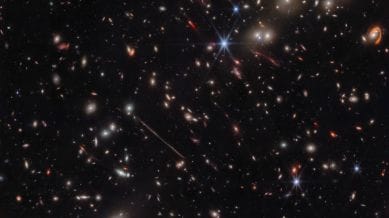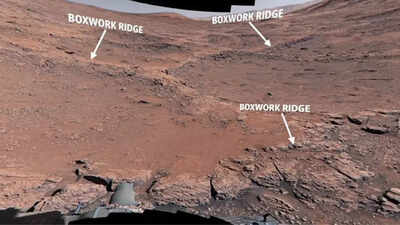The James Webb Space Telescope took one of the most detailed images of “teenage galaxies,” helping scientists understand how galaxies form and evolve.

“Teenage galaxies” that formed just two to three billion years after the Big Bang are unusually hot and glow with light from elements like nickel. Looking into these galaxies tell scientists more about how these massive systems of stars grow and evolve.
Research published yesterday in The Astrophysical Journal Letters is part of the (Chemical Evolution Constrained using Ionized Lines in Interstellar Aurorae) survey. Scientists in July pointed the James Webb Space Telescope at 33 ancient galaxies whose light travelled more than 10 billion years to reach us and looked at them for more than a day. In the process, they captured the most detailed view of these galaxies ever captured.
You have exhausted your
monthly limit of free stories.
Read more stories for free
with an Express account.
Continue reading this and other premium stories with an Express subscription. Use promo code DIWALI30 to get 30% off.
This premium article is free for now.
Register to read more free stories and access offers from partners.
Continue reading this and other premium stories with an Express subscription. Use promo code DIWALI30 to get 30% off.
This content is exclusive for our subscribers.
Subscribe now to get unlimited access to The Indian Express exclusive and premium stories.
Most Read
Some galaxies that exited in the universe’s youth, like the 33 chosen for the study, went through periods of intense star formation. More modern galaxies, like the Milky Way, still form stars but not nearly as fast. Some others have completely stopped forming stars. This new research can help astronomers understand how different galaxies go through these different paths, according to the Carnegie Institution for Science.
Scientists working on the CECILIA project observed spectra from these distant galaxies. They separated the light into component wavelengths. This helped them measure the temperature and chemical composition of the sources of light. Using this technique, they identified eight different elements —- hydrogen, helium, nitrogen, oxygen, silicon, sulphur, argon, and nickel. The team was particularly surprised to detect nickel.
All elements that are heavier than hydrogen and helium are formed inside stars. When stars explode, they throw out these elements into their cosmic neighbourhood, where they eventually become part of the next generation of stars.
© IE Online Media Services Pvt Ltd
First published on: 21-11-2023 at 1:27 pm IST







